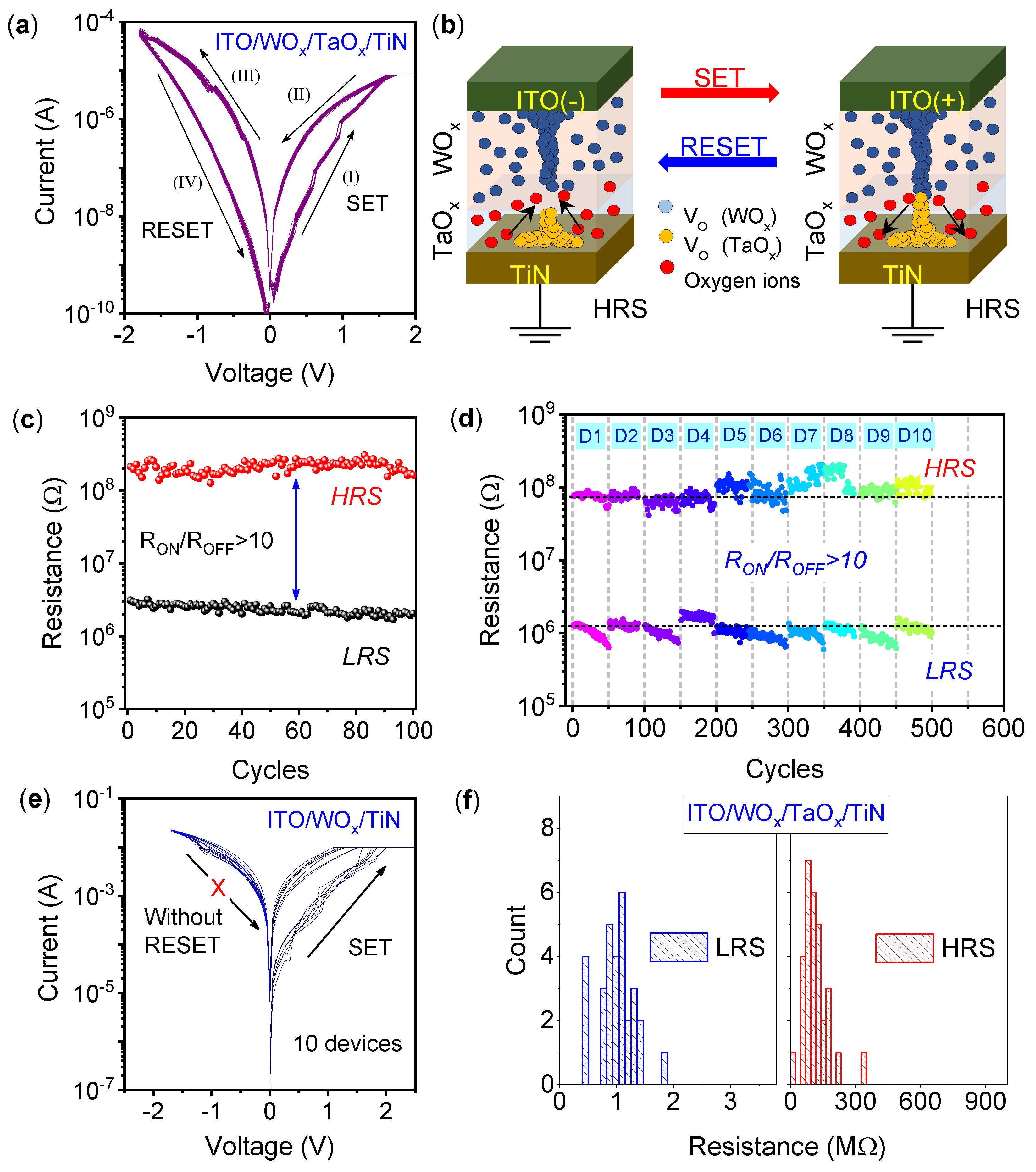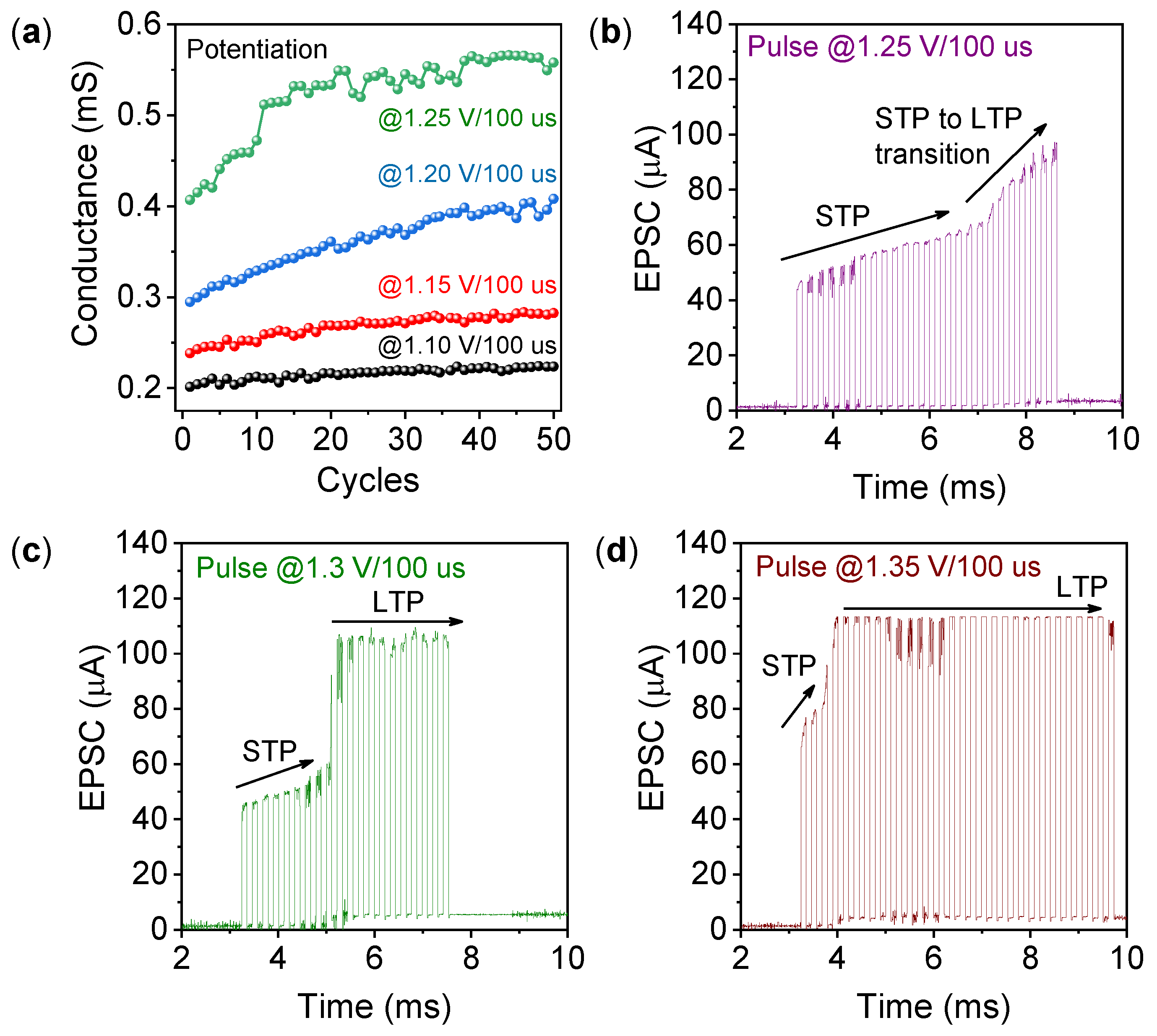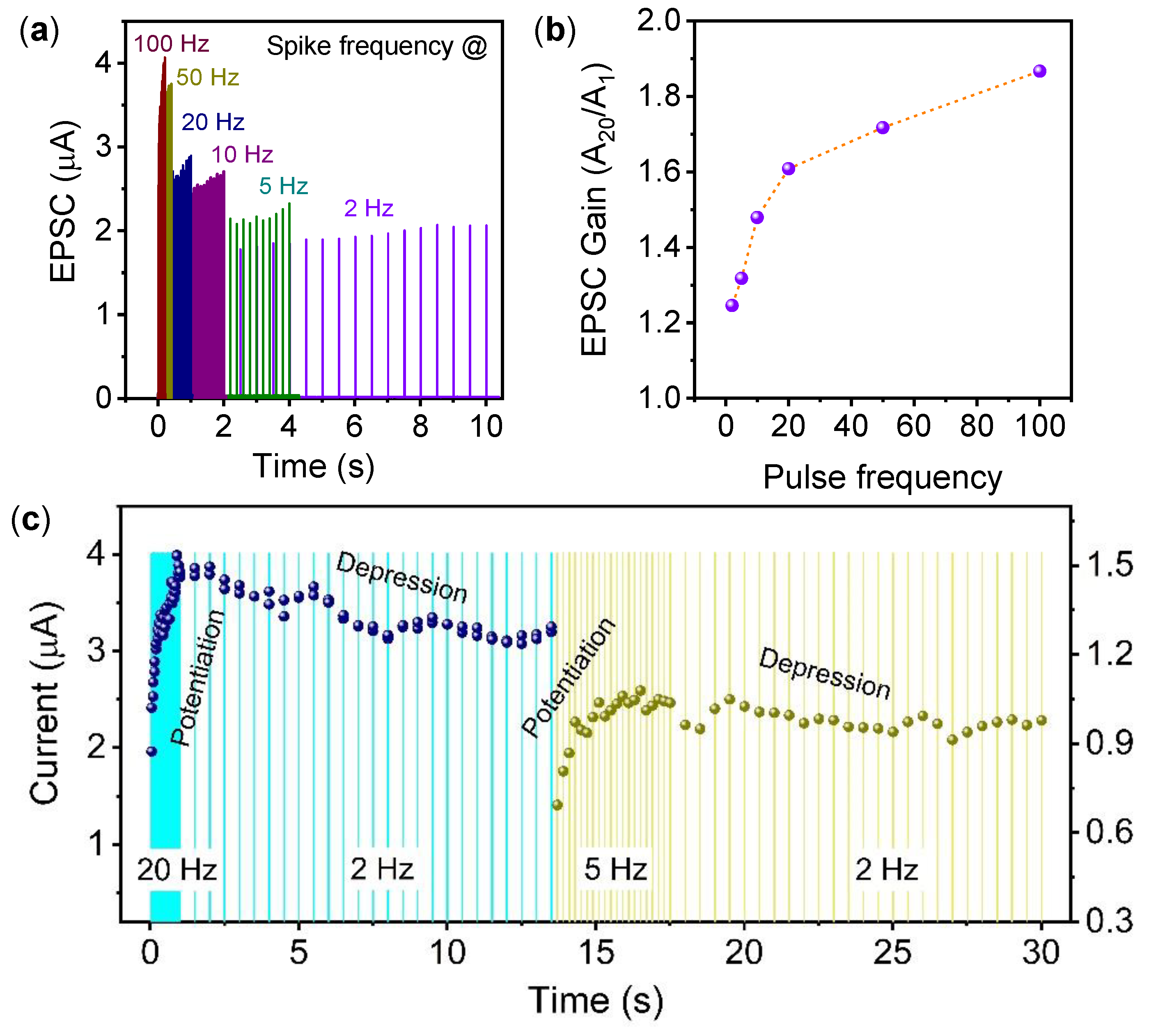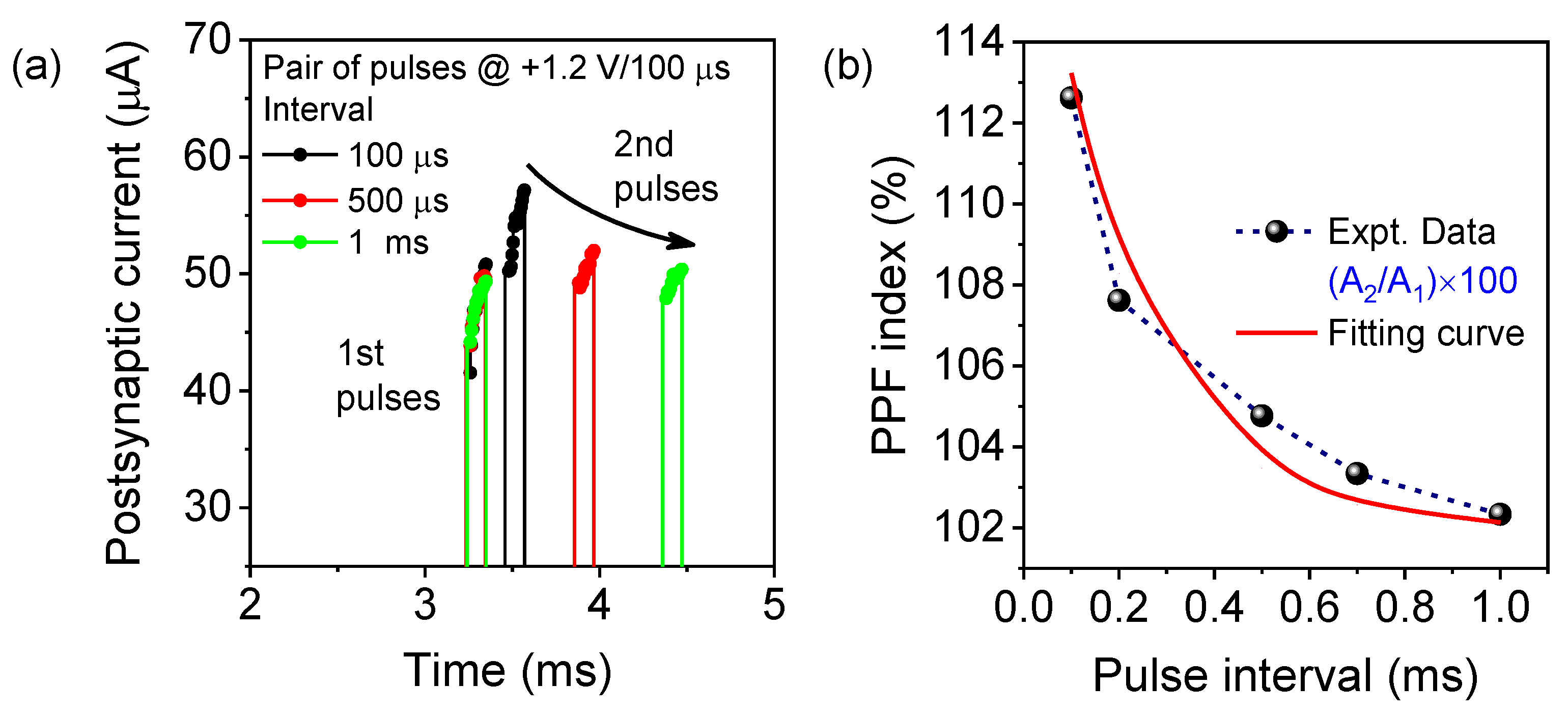Forming-Free Tunable Analog Switching in WOx/TaOx Heterojunction for Emulating Electronic Synapses
Abstract
1. Introduction
2. Materials and Methods
3. Results and Discussion
3.1. Gradual Bipolar Resistive Switching of the ITO/WOx/TaOx/TiN Device
3.2. Synaptic Characteristics under an Identical Pulse Sequence
3.3. Pulse Frequency-Dependent Synaptic Properties
3.4. Paired-Pulse Facilitation (PPF) Emulation
4. Conclusions
Author Contributions
Funding
Institutional Review Board Statement
Informed Consent Statement
Data Availability Statement
Conflicts of Interest
References
- Wang, T.; Brivio, S.; Cianci, E.; Wiemer, C.; Perego, M.; Spiga, S.; Lanza, M. Improving HfO2-Based Resistive Switching Devices by Inserting a TaOxThin Film via Engineered In Situ Oxidation. ACS Appl. Mater. Interfaces 2022, 14, 24565–24574. [Google Scholar] [CrossRef] [PubMed]
- Sung, J.H.; Park, J.H.; Jeon, D.S.; Kim, D.; Yu, M.J.; Khot, A.C.; Dongale, T.D.; Kim, T.G. Retention enhancement through capacitance-dependent voltage division analysis in 3D stackable TaOx/HfO2-based selectorless memristor. Mater. Des. 2021, 207, 109845. [Google Scholar] [CrossRef]
- Luo, Q.; Xu, X.; Liu, H.; Lv, H.; Gong, T.; Long, S.; Liu, Q.; Sun, H.; Banerjee, W.; Li, L.; et al. Demonstration of 3D vertical RRAM with ultra low-leakage, high-selectivity and self-compliance memory cells. In Proceedings of the IEEE International Electron Devices Meeting (IEDM), Washington, DC, USA, 7–9 December 2015; pp. 10.2.1–10.2.4. [Google Scholar]
- Ielmini, D. Resistive switching memories based on metal oxides: Mechanisms, reliability and scaling. Semicond. Sci. Technol. 2016, 31, 063002. [Google Scholar] [CrossRef]
- Yu, S.; Gao, B.; Fang, Z.; Yu, H.; Kang, J.; Wong, H.S.P. A low energy oxide-based electronic synaptic device for neuromorphic visual systems with tolerance to device variation. Adv. Mater. 2013, 25, 1774–1779. [Google Scholar] [CrossRef] [PubMed]
- Sugawara, K.; Shima, H.; Takahashi, M.; Naitoh, Y.; Suga, H.; Akinaga, H. Low-Frequency-Noise Spectroscopy of TaOx-based Resistive Switching Memory. Adv. Electron. Mater. 2022, 8, 2100758. [Google Scholar] [CrossRef]
- Celano, U.; Goux, L.; Degraeve, R.; Fantini, A.; Richard, O.; Bender, H.; Jurczak, M.; Vandervorst, W. Imaging the Three-Dimensional Conductive Channel in Filamentary-Based Oxide Resistive Switching Memory. Nano Lett. 2015, 15, 7970–7975. [Google Scholar] [CrossRef] [PubMed]
- Park, G.-S.; Kim, Y.B.; Park, S.Y.; Li, X.S.; Heo, S.; Lee, M.-J.; Chang, M.; Kwon, J.H.; Kim, M.; Chung, U.-I.; et al. In situ observation of filamentary conducting channels in an asymmetric Ta2O5−x/TaO2−x bilayer structure. Nat. Commun. 2013, 4, 2382. [Google Scholar] [CrossRef]
- Zhang, Z.; Wang, Z.; Shi, T.; Bi, C.; Rao, F.; Cai, Y.; Liu, Q.; Wu, H.; Zhou, P. Memory materials and devices: From concept to application. InfoMat 2020, 2, 261–290. [Google Scholar] [CrossRef]
- Majumdar, S.; Tan, H.; Qin, Q.H.; van Dijken, S. Energy-Efficient Organic Ferroelectric Tunnel Junction Memristors for Neuromorphic Computing. Adv. Electron. Mater. 2019, 5, 1800795. [Google Scholar] [CrossRef]
- Lim, S.; Kwak, M.; Hwang, H. One transistor-two resistive RAM device for realizing bidirectional and analog neuromorphic synapse devices. Nanotechnology 2019, 30, 455201. [Google Scholar] [CrossRef]
- Wu, Y.; Yu, S.; Lee, B.; Wong, P. Low-power TiN/Al2O3/Pt resistive switching device with sub-20 A switching current and gradual resistance modulation. J. Appl. Phys. 2011, 110, 3–8. [Google Scholar] [CrossRef]
- Huang, R.; Yan, X.; Ye, S.; Kashtiban, R.; Beanland, R.; Morgan, K.A.; Charlton, M.D.B.; de Groot, C.H. Compliance-free ZrO2/ZrO2−x/ZrO2 resistive memory with controllable interfacial multistate switching behaviour. Nanoscale Res. Lett. 2017, 12, 384. [Google Scholar] [CrossRef] [PubMed]
- Yu, S.; Guan, X.; Wong, H.S.P. Conduction mechanism of TiNHfO xPt resistive switching memory: A trap-assisted-tunneling model. Appl. Phys. Lett. 2011, 99, 16–19. [Google Scholar] [CrossRef]
- Bousoulas, P.; Karageorgiou, I.; Aslanidis, V.; Giannakopoulos, K.; Tsoukalas, D. Tuning Resistive, Capacitive, and Synaptic Properties of Forming Free TiO2-x-Based RRAM Devices by Embedded Pt and Ta Nanocrystals. Phys. Status Solidi Appl. Mater. Sci. 2018, 215, 1700440. [Google Scholar] [CrossRef]
- Chen, Y.C.; Chung, Y.L.; Chen, B.T.; Chen, W.C.; Chen, J.S. Revelation on the interrelated mechanism of polarity-dependent and multilevel resistive switching in TaOx-based memory devices. J. Phys. Chem. C 2013, 117, 5758–5764. [Google Scholar] [CrossRef]
- Chen, W.J.; Cheng, C.H.; Lin, P.E.; Tseng, Y.T.; Chang, T.C.; Chen, J.S. Analog Resistive Switching and Synaptic Functions in WOx/TaOxBilayer through Redox-Induced Trap-Controlled Conduction. ACS Appl. Electron. Mater. 2019, 1, 2422–2430. [Google Scholar] [CrossRef]
- Wang, B.; Xue, K.H.; Sun, H.J.; Li, Z.N.; Wu, W.; Yan, P.; Liu, N.; Tian, B.Y.; Liu, X.X.; Miao, X.S. Performance enhancement of TaO x resistive switching memory using graded oxygen content. Appl. Phys. Lett. 2018, 113, 183501. [Google Scholar] [CrossRef]
- Ma, Y.; Cullen, D.A.; Goodwill, J.M.; Xu, Q.; More, K.L.; Skowronski, M. Exchange of Ions across the TiN/TaO xInterface during Electroformation of TaO x-Based Resistive Switching Devices. ACS Appl. Mater. Interfaces 2020, 12, 27378–27385. [Google Scholar] [CrossRef]
- Kim, S.; Biju, K.P.; Jo, M.; Jung, S.; Park, J.; Lee, J.; Lee, W.; Shin, J.; Park, S.; Hwang, H. Effect of scaling WOx-Based RRAMs on their resistive switching characteristics. IEEE Electron. Device Lett. 2011, 32, 671–673. [Google Scholar] [CrossRef]
- Won, S.; Lee, S.Y.; Park, J.; Seo, H. Forming-less and Non-Volatile Resistive Switching in by Oxygen Vacancy Control at Interfaces. Sci. Rep. 2017, 7, 10186. [Google Scholar] [CrossRef]
- Luo, Q.; Xu, X.; Gong, T.; Lv, H.; Dong, D.; Ma, H.; Yuan, P.; Gao, J.; Liu, J.; Yu, Z.; et al. 8-Layers 3D vertical RRAM with excellent scalability towards storage class memory applications. In Proceedings of the IEEE International Electron Devices Meeting (IEDM), San Francisco, CA, USA, 2–6 December 2017; pp. 2.7.1–2.7.4. [Google Scholar]
- Gao, S.; Zeng, F.; Li, F.; Wang, M.; Mao, H.; Wang, G.; Song, C.; Pan, F. Forming-free and self-rectifying resistive switching of the simple Pt/TaOx/n-Si structure for access device-free high-density memory application. Nanoscale 2015, 7, 6031–6038. [Google Scholar] [CrossRef] [PubMed]
- Ricci, S.; Mannocci, P.; Farronato, M.; Hashemkhani, S.; Ielmini, D. Forming-Free Resistive Switching Memory Crosspoint Arrays for In-Memory Machine Learning. Adv. Intell. Syst. 2022, 4, 2200053. [Google Scholar] [CrossRef]
- Shuai, Y.; Ou, X.; Luo, W.; Mücklich, A.; Bürger, D.; Zhou, S.; Wu, C.; Chen, Y.; Zhang, W.; Helm, M.; et al. Key concepts behind forming-free resistive switching incorporated with rectifying transport properties. Sci. Rep. 2013, 3, 2208. [Google Scholar] [CrossRef] [PubMed]
- Baek, G.H.; Lee, A.R.; Kim, T.Y.; Im, H.S.; Hong, J.P. Oxide stoichiometry-controlled TaOx-based resistive switching behaviors. Appl. Phys. Lett. 2016, 109, 143502. [Google Scholar] [CrossRef]
- Sakellaropoulos, D.; Bousoulas, P.; Nikas, G.; Arvanitis, C.; Bagakis, E.; Tsoukalas, D. Enhancing the synaptic properties of low-power and forming-free HfOx/TaOy/HfOx resistive switching devices. Microelectron. Eng. 2020, 229, 111358. [Google Scholar] [CrossRef]
- Zhou, Q.; Zhai, J. The improved resistive switching properties of TaOx-based RRAM devices by using WNx as bottom electrode. Phys. B Condens. Matter 2013, 410, 85–89. [Google Scholar] [CrossRef]
- Chakrabarti, S.; Panja, R.; Roy, S.; Roy, A.; Samanta, S.; Dutta, M.; Ginnaram, S.; Maikap, S.; Cheng, H.M.; Tsai, L.N.; et al. Evolution of resistive switching mechanism through H2O2 sensing by using TaO x-based material in W/Al2O3/TaOx/TiN structure. Appl. Surf. Sci. 2018, 433, 51–59. [Google Scholar] [CrossRef]
- Prakash, A.; Jana, D.; Samanta, S.; Maikap, S. Self-compliance-improved resistive switching using Ir/TaOx/W cross-point memory. Nanoscale Res. Lett. 2013, 8, 527. [Google Scholar] [CrossRef]
- Wang, Z.; Yin, M.; Zhang, T.; Cai, Y.; Wang, Y.; Yang, Y.; Huang, R. Engineering incremental resistive switching in TaO: X based memristors for brain-inspired computing. Nanoscale 2016, 8, 14015–14022. [Google Scholar] [CrossRef]
- Li, Z.; Tian, B.; Xue, K.H.; Wang, B.; Xu, M.; Lu, H.; Sun, H.; Miao, X. Coexistence of digital and analog resistive switching with low operation voltage in oxygen-gradient HfOx Memristors. IEEE Electron. Device Lett. 2019, 40, 1068–1071. [Google Scholar] [CrossRef]
- Prakash, A.; Park, J.; Song, J.; Woo, J.; Cha, E.-J.; Hwang, H. Demonstration of Low Power 3-bit Multilevel Cell Characteristics in a TaOx-Based RRAM by Stack Engineering. IEEE Electron. Device Lett. 2015, 36, 32–34. [Google Scholar] [CrossRef]
- Mehonic, A.; Buckwell, M.; Montesi, L.; Garnett, L.; Hudziak, S.; Fearn, S.; Chater, R.; McPhail, D.; Kenyon, A.J. Structural changes and conductance thresholds in metal-free intrinsic SiO x resistive random access memory. J. Appl. Phys. 2015, 117, 124505. [Google Scholar] [CrossRef]
- Zhou, L.; Yang, S.; Ding, G.; Yang, J.Q.; Ren, Y.; Zhang, S.R.; Mao, J.Y.; Yang, Y.; Zhou, Y.; Han, S.T. Tunable synaptic behavior realized in C 3 N composite based memristor. Nano Energy 2019, 58, 293–303. [Google Scholar] [CrossRef]
- Hao, S.; Ji, X.; Liu, F.; Zhong, S.; Pang, K.Y.; Lim, K.G.; Chong, T.C.; Zhao, R. Monolayer MoS2/WO3Heterostructures with Sulfur Anion Reservoirs as Electronic Synapses for Neuromorphic Computing. ACS Appl. Nano Mater. 2021, 4, 1766–1775. [Google Scholar] [CrossRef]
- Kim, M.K.; Lee, J.S. Short-Term Plasticity and Long-Term Potentiation in Artificial Biosynapses with Diffusive Dynamics. ACS Nano 2018, 12, 1680–1687. [Google Scholar] [CrossRef]
- La Barbera, S.; Vincent, A.F.; Vuillaume, D.; Querlioz, D.; Alibart, F. Interplay of multiple synaptic plasticity features in filamentary memristive devices for neuromorphic computing. Sci. Rep. 2016, 6, 39216. [Google Scholar] [CrossRef]
- Chang, T.; Jo, S.H.; Lu, W. Short-term memory to long-term memory transition in a nanoscale memristor. ACS Nano 2011, 5, 7669–7676. [Google Scholar] [CrossRef]
- Li, J.; Ge, C.; Lu, H.; Guo, H.; Guo, E.J.; He, M.; Wang, C.; Yang, G.; Jin, K. Energy-Efficient Artificial Synapses Based on Oxide Tunnel Junctions. ACS Appl. Mater. Interfaces 2019, 11, 43473–43479. [Google Scholar] [CrossRef]
- Yan, X.; Zhao, Q.; Chen, A.P.; Zhao, J.; Zhou, Z.; Wang, J.; Wang, H.; Zhang, L.; Li, X.; Xiao, Z.; et al. Vacancy-Induced Synaptic Behavior in 2D WS2 Nanosheet–Based Memristor for Low-Power Neuromorphic Computing. Small 2019, 15, 1901423. [Google Scholar] [CrossRef]
- Li, X.; Yu, B.; Wang, B.; Bao, L.; Zhang, B.; Li, H.; Yu, Z.; Zhang, T.; Yang, Y.; Huang, R.; et al. Multi-terminal ionic-gated low-power silicon nanowire synaptic transistors with dendritic functions for neuromorphic systems. Nanoscale 2020, 12, 16348–16358. [Google Scholar] [CrossRef]
- Parmar, V.; Kingra, S.K.; Suri, M. Short-term plasticity circuit device exploration in the MASTISK neuromorphic framework. J. Phys. D Appl. Phys. 2018, 51, 454004. [Google Scholar] [CrossRef]
- Zhu, L.Q.; Wan, C.J.; Guo, L.Q.; Shi, Y.; Wan, Q. Artificial synapse network on inorganic proton conductor for neuromorphic systems. Nat. Commun. 2014, 5, 3158. [Google Scholar] [CrossRef]
- Abbott, L.F.; Regehr, W.G. Synaptic computation. Nature 2004, 431, 796–803. [Google Scholar] [CrossRef]
- Khanas, A.; Hebert, C.; Becerra, L.; Portier, X.; Jedrecy, N. Second-Order Memristor Based on All-Oxide Multiferroic Tunnel Junction for Biorealistic Emulation of Synapses. Adv. Electron. Mater. 2022, 8, 2200421. [Google Scholar] [CrossRef]
- Guo, J.; Liu, Y.; Li, Y.; Li, F.; Huang, F. Bienenstock-Cooper-Munro Learning Rule Realized in Polysaccharide-Gated Synaptic Transistors with Tunable Threshold. ACS Appl. Mater. Interfaces 2020, 12, 50061–50067. [Google Scholar] [CrossRef]
- Wu, Y.; Wang, X.; Lu, W.D. Dynamic resistive switching devices for neuromorphic computing. Semicond. Sci. Technol. 2022, 37, 024003. [Google Scholar] [CrossRef]
- Kyu Yang, M.; Ju, H.; Hwan Kim, G.; Lee, J.K.; Ryu, H.C. Direct evidence on Ta-metal phases igniting resistive switching in TaOx thin film. Sci. Rep. 2015, 5, 14053. [Google Scholar] [CrossRef]
- Wang, R.; Shi, T.; Zhang, X.; Wu, Z.; Liu, Q. A dual-functional Ta/TaO: X/Ru device with both nonlinear selector and resistive switching behaviors. RSC Adv. 2021, 11, 18241–18245. [Google Scholar] [CrossRef]
- Kim, S.; Abbas, Y.; Jeon, Y.R.; Sokolov, A.S.; Ku, B.; Choi, C. Engineering synaptic characteristics of TaOx/HfO2 bi-layered resistive switching device. Nanotechnology 2018, 29, 415204. [Google Scholar] [CrossRef]
- Jung, P.Y.; Panda, D.; Chandrasekaran, S.; Rajasekaran, S.; Tseng, T.Y. Enhanced Switching Properties in TaOx Memristors Using Diffusion Limiting Layer for Synaptic Learning. IEEE J. Electron. Devices Soc. 2020, 8, 110–115. [Google Scholar] [CrossRef]
- Lee, S.H.; Moon, J.; Jeong, Y.J.; Lee, J.; Li, X.; Wu, H.; Lu, W.D. Quantitative, Dynamic TaOxMemristor/Resistive Random Access Memory Model. ACS Appl. Electron. Mater. 2020, 2, 701–709. [Google Scholar] [CrossRef]





| Device Structure | VSET (V) | VRESET (V) | ON/OFF Ratio | Switching Characteristics | Device-to- Device Reliability | Synaptic Properties | Ref. |
|---|---|---|---|---|---|---|---|
| Ta/TaOx/Pt | +0.65 V | –0.6 V | >10 | Abrupt | N/A | N/A | [49] |
| Ir/TaOx/W | +2.5 V | –2.5 V | >10 | Gradual | N/A | N/A | [30] |
| W/Ta/TaOx/ Pt | +0.75 V | –1.5 V | >10 | Gradual | N/A | N/A | [33] |
| Ta/TaOx/Ru | –1.5 V | +2.0 V | >100 | Abrupt | N/A | N/A | [50] |
| Pt/TaOx/n-Si | –2.5 V | +1.5 V | >10 | Abrupt | N/A | N/A | [23] |
| Pt/TaOx/Ta | –0.8 V | +1.0 V | >10 | Abrupt | N/A | N/A | [26] |
| Pt/TaOx/Ta | –0.8 V | +1.0 V | >10 | Gradual | N/A | N/A | [18] |
| Ti/TaOx/HfO2/Pt | +1.5 V | –1.7 V | <10 | Gradual | N/A | PD, STDP | [51] |
| TaN/Ta/TaOx/ Al2O3/Pt | +1.5 V | –1.8 V | <10 | Gradual | N/A | PD | [52] |
| TiN/SiO2/ TaOx/Pt | +0.5 V | –1.5 V | >10 | Gradual | N/A | PD, STDP | [31] |
| TaN/Ta/HfO2/ TaOx/Pt | +0.7 V | –0.9 V | >10 | Gradual | N/A | PD | [1] |
| TiN/Ti/TaOy/HfOx/ Au | –5.0 V | +5.0 V | >10 | Gradual | N/A | PD, STDP | [27] |
| W/Al2O3/TaOx/ TiN | +1.5 V | –2.2 V | <10 | Gradual | N/A | N/A | [29] |
| Pt/TaOx/HfO2/Pt | +10 V | –5.0 V | >10 | Gradual | N/A | N/A | [2] |
| Ta/WOx/TaOx/Pt | –4.0 V | +4.0 V | >10 | Gradual | N/A | PD, PPF, SRDP | [17] |
| Pd/Ta2O5/TaOx/Pd | –1.8 V | +1.0 V | >10 | Gradual | N/A | PD | [53] |
| ITO/WOx/TaOx/ TiN | +1.5 | –1.8 V | >10 | Gradual | Good (Figure 1d) | PD, STP, LTP, SADP, SRDP, PPF | This work |
Publisher’s Note: MDPI stays neutral with regard to jurisdictional claims in published maps and institutional affiliations. |
© 2022 by the authors. Licensee MDPI, Basel, Switzerland. This article is an open access article distributed under the terms and conditions of the Creative Commons Attribution (CC BY) license (https://creativecommons.org/licenses/by/4.0/).
Share and Cite
Mahata, C.; Pyo, J.; Jeon, B.; Ismail, M.; Kang, M.; Kim, S. Forming-Free Tunable Analog Switching in WOx/TaOx Heterojunction for Emulating Electronic Synapses. Materials 2022, 15, 8858. https://doi.org/10.3390/ma15248858
Mahata C, Pyo J, Jeon B, Ismail M, Kang M, Kim S. Forming-Free Tunable Analog Switching in WOx/TaOx Heterojunction for Emulating Electronic Synapses. Materials. 2022; 15(24):8858. https://doi.org/10.3390/ma15248858
Chicago/Turabian StyleMahata, Chandreswar, Juyeong Pyo, Beomki Jeon, Muhammad Ismail, Myounggon Kang, and Sungjun Kim. 2022. "Forming-Free Tunable Analog Switching in WOx/TaOx Heterojunction for Emulating Electronic Synapses" Materials 15, no. 24: 8858. https://doi.org/10.3390/ma15248858
APA StyleMahata, C., Pyo, J., Jeon, B., Ismail, M., Kang, M., & Kim, S. (2022). Forming-Free Tunable Analog Switching in WOx/TaOx Heterojunction for Emulating Electronic Synapses. Materials, 15(24), 8858. https://doi.org/10.3390/ma15248858









